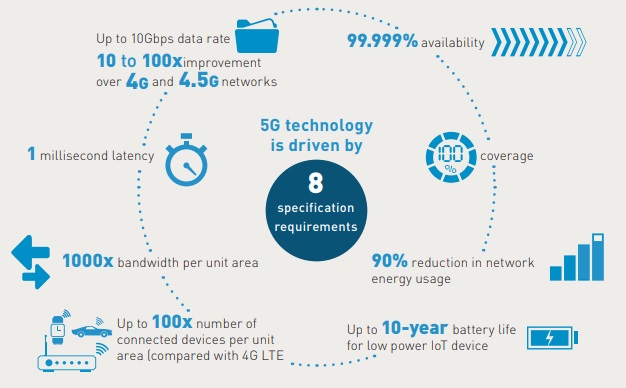Shop At Haya: Your Ultimate Shopping Guide
Discover the best shopping tips, trends, and deals for a smarter buying experience.
5G: The Speedy Revolution You Didn't See Coming
Discover how 5G is transforming our world at lightning speed! Don't miss the revolution that everyone is talking about!
What is 5G and How Does it Work?
5G, or fifth-generation wireless technology, is the latest advancement in mobile networks, designed to significantly enhance connectivity speeds, reliability, and capacity compared to its predecessors. It operates on a broader spectrum of frequencies, utilizing millimeter-wave bands that allow for faster data transmission. With 5G, users can experience lag-free browsing and streaming, as well as support for a larger number of devices simultaneously. This technology is crucial for enabling the growing number of Internet of Things (IoT) devices, autonomous vehicles, and smart city infrastructure.
At its core, 5G technology utilizes a combination of small cells, massive MIMO (Multiple Input Multiple Output), and beamforming techniques to optimize network performance. Small cells help to reduce the distance between the user and the cell tower, thereby increasing data throughput and lowering latency. Meanwhile, massive MIMO employs multiple antennas at the transmitter and receiver ends, enhancing the network's capacity to handle multiple connections within the same area. Collectively, these innovations contribute to a more responsive and efficient mobile experience, paving the way for revolutionary applications across various industries.

The Impact of 5G on Everyday Life: What You Need to Know
The advent of 5G technology is set to revolutionize our daily lives in ways we are just beginning to grasp. With significantly faster download and upload speeds—potentially up to 100 times faster than 4G—5G promises to enhance everything from streaming high-definition videos to seamless online gaming experiences. Moreover, its low latency will transform real-time applications, such as virtual reality and augmented reality, providing users with smoother and more immersive experiences. As smart devices become increasingly integrated into our lives, the impact of 5G will extend beyond personal entertainment, ushering in smarter cities and improved connectivity for various industries.
In addition to entertainment and connectivity, 5G holds the potential to enhance critical services such as healthcare and transportation. For example, telemedicine can be significantly improved with real-time data transfer, allowing for quicker diagnosis and treatment from healthcare professionals. Likewise, autonomous vehicles will rely on 5G connectivity to communicate with each other and traffic systems, ultimately leading to safer and more efficient roadways. As 5G continues to roll out, understanding its implications for everyday life will become essential, equipping individuals and businesses to leverage its full potential and stay ahead in a rapidly changing digital landscape.
Is 5G Safe? Debunking Myths and Addressing Concerns
The advent of 5G technology has sparked a wave of discussion and concern regarding its safety. Many people are apprehensive about potential health risks associated with increased exposure to radiofrequency electromagnetic fields. However, extensive research conducted by reputable organizations, including the World Health Organization (WHO) and the Federal Communications Commission (FCC), has concluded that 5G is safe for public use. These studies indicate that the levels of radiofrequency energy emitted by 5G networks are well below the limits set by international standards, debunking various myths surrounding the technology.
Despite the overwhelming scientific consensus, misinformation continues to circulate regarding 5G safety. Some commonly quoted myths include the belief that 5G technology causes cancer or contributes to the spread of COVID-19. However, these claims have been categorically denied by experts in the field. 5G operates on non-ionizing radiation, which is fundamentally different from ionizing radiation that has been linked to cancer. It is essential for consumers to rely on credible sources and expert opinions when assessing the safety of new technologies rather than falling victim to sensational headlines and unfounded theories.